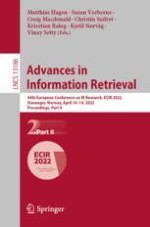1 Introduction
2 Related Work
3 Method
3.1 Statistics-Based Approach
3.2 Zero-Shot Generation Based on Adapted External Corpus
3.3 Ensemble Approach to Query Generation
4 Experiments
Amazon.com. As shown in Table 1, we consider headphones, tents and conditioners to evaluate our method across diverse product types, for which people tend to behave and shop differently with variances reflected in search queries. The query vocabulary size for conditioners, for instance, is about thrice the size of tents, with headphones sitting in-between the two.Headphone | Tent | Conditioner | ||||
|---|---|---|---|---|---|---|
Dev | Test | Dev | Test | Dev | Test | |
# of reviews | 23,165 | 23,623 | 19,208 | 18,734 | 17,055 | 17,689 |
# of sentences | 102,281 | 103,771 | 97,553 | 97,320 | 68,691 | 70,829 |
4.1 Intrinsic Similarity Evaluation
Headphone | Tent | Conditioner | ||||
|---|---|---|---|---|---|---|
BLEU | METEOR | BLEU | METEOR | BLEU | METEOR | |
YAKE | 0.1014 | 0.1371 | 0.2794 | 0.2002 | 0.3143 | 0.1998 |
Doc2Query | 0.1589 | 0.1667 | 0.3684 | 0.2145 | 0.4404 | 0.264 |
Stats-base | 0.1743 | 0.2001 | 0.3294 | 0.2201 | 0.4048 | 0.2723 |
Stats-s2s | 0.1838 | 0.2004 | 0.321 | 0.2189 | 0.3931 | 0.2641 |
Ensemble | 0.2106\(^{\star }\) | 0.2024 | 0.394\(^{\star }\) | 0.2334\(^{\star }\) | 0.5047\(^{\star }\) | 0.2956\(^{\star }\) |
Examples | Noise cancelling headphone Truck driver headphone Hearing aids headphone | Lightweight tent Alps backpacking tent Air mattresses queen tent | Detangling conditioner Shea moisture conditioner Dry hair conditioner | |||
4.2 Extrinsic Retrieval Evaluation
Headphone | Tent | Conditioner | |||||||
|---|---|---|---|---|---|---|---|---|---|
MRR | P@1 | P@10 | MRR | P@1 | P@10 | MRR | P@1 | P@10 | |
BM25 | 0.28 | 0.19 | 0.06 | 0.43 | 0.29 | 0.11 | 0.56 | 0.47 | 0.14 |
YAKE | 0.23 | 0.11 | 0.07 | 0.46 | 0.34 | 0.11 | 0.54 | 0.43 | 0.14 |
Doc2Query | 0.28 | 0.18 | 0.08 | 0.49 | 0.40 | 0.12 | 0.58 | 0.49 | 0.15 |
Stats-base | 0.28 | 0.16 | 0.07 | 0.44 | 0.29 | 0.12 | 0.54 | 0.42 | 0.15 |
Stats-s2s | 0.27 | 0.17 | 0.07 | 0.44 | 0.32 | 0.12 | 0.56 | 0.46 | 0.16 |
Ensemble | 0.29 | 0.20 | 0.07 | 0.46 | 0.33 | 0.13 | 0.59 | 0.48 | 0.15 |
